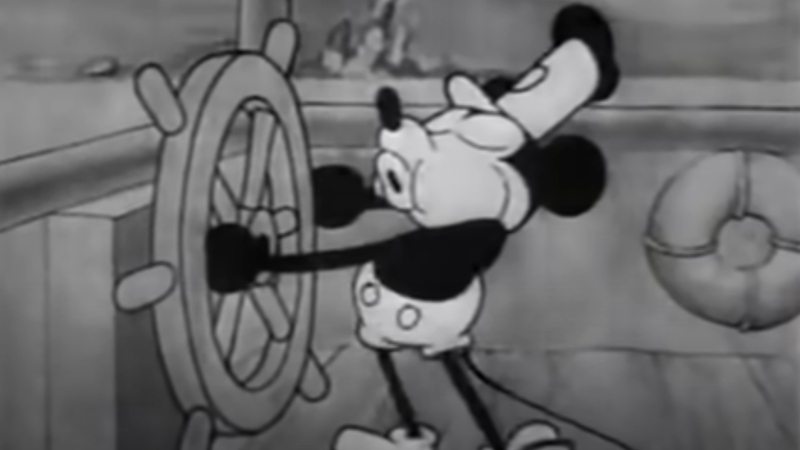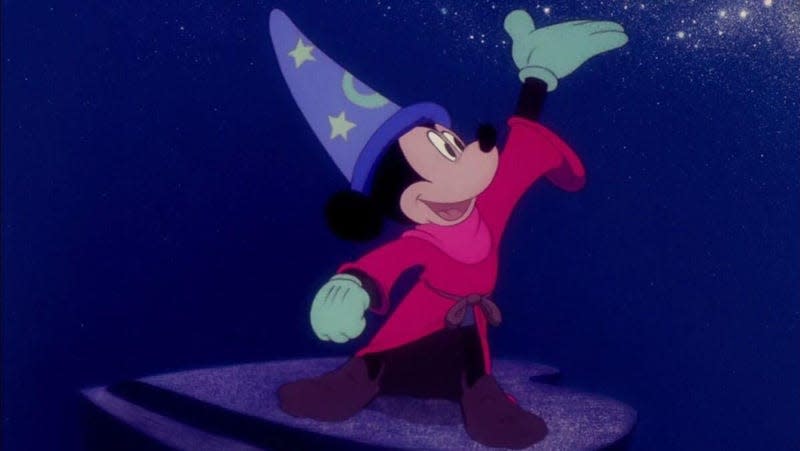Everything You Need to Know About Mickey Mouse's Public Domain Debut Today

- Oops!Something went wrong.Please try again later.
Mickey Mouse is finally in the hands of the public, to do whatever they want with him. Well, in part. After Disney infamously helped delay the moment, today is the day Steamboat Willie, the first Disney animated short to star Mickey and Minnie Mouse, become public domain. But what does that mean? Simultaneously a lot and not much.
Why Is Steamboat Willie Entering Public Domain?
Legal copyright doesn’t last forever—and was never meant to. Copyright law is meant to balance a fine line between creators being able to have a legal stake in (and ability to financially profit from) their works for the duration of their lives, and the larger public good of having those works enter the public forum, where anyone can remix and reuse them, and develop new iterations, but also crucially archivists can safely collect and copy historical work for safekeeping without threat of legal reprisal.
Read more
These Are The Black Celebs Who Were Named On Jeffrey Epstein's List
Wanna watch a smart woman totally body two stupid hockey men?

What Can People Do With Steamboat Willie Now?
Anything they want! Within limits. In the case of Mickey and Minnie specifically, the version that is now in the public domain is very specifically the designs that appeared in Steamboat Willie and the silent film Plane Crazy. Over the last near-century Disney has iterated on Mickey’s design, bringing him into color, changing elements (such as adding his trademark white gloves in 1929), and evolving his general features, perhaps most notably the shape and design of his eyes. For the most part, the things that make the modern Mickey Mickey—and form the basis for Disney’s current ownership of the rest of the character’s history—were first introduced in 1940 with the anthology film Fantasia (itself, ironically, a product that heavily utilized public domain music, and Mickey’s starring role in the “The Sorcerer’s Apprentice” sequence was inspired by Johann Wolfgang von Goethe’s poetic ballad of the same name).
Creators can add elements perhaps evocative of latter Mickeys and Minnies to the Steamboat designs—voices that they didn’t have in the 1928 material, colorized elements, general character traits like their affable nature—as these are elements that don’t actually reach the pretty low standards for copyrightable expression. They can also add entirely different interpretations and additions to those designs that are original elements unrelated to anything Disney has done with Mickey in the years since. What they can’t do is use either any of those still-copyrighted elements like the ones added for Fantasia and beyond, nor can they willingly mislead audiences into thinking their Mickey material is either sponsored by Disney or actually produced by the studio—that’s still protected by the trademarks owned by Disney, and operates under a different legal space. Most notably, unlike copyright, trademarks don’t expire after a certain date.
What Will Disney Do?
Nothing—and it doesn’t really need to. “Ever since Mickey Mouse’s first appearance in the 1928 short film Steamboat Willie, people have associated the character with Disney’s stories, experiences, and authentic products,” Disney said in a statement to the Associated Press in the run up to Steamboat Willie entering public domain. “That will not change when the copyright in the Steamboat Willie film expires.”
That might have some “please dont put in the newspaper that i got mad” energy, but while the short’s arrival in the public domain is a major milestone in copyright law, in terms of its overall impact on Disney it’s still relatively minor in the grand scheme of all things House of Mouse. As previously mentioned, Disney still has copyrighted ownership over the design elements of Mickey that for the most part are what the public thinks of when they think of the character—and they also have trademarks on Mickey as a brand identifier that will make a lot of public domain use of the character an intimidating challenge for some creators, especially considering Disney has trademarks on the Mickey and Minnie Mouse names. The company even still has some trademark elements for Steamboat Willie itself: in 2022, Disney updated its trademark on the Walt Disney Animation Studios logo, which, 15 years prior in 2007, had been updated to include a snippet of Mickey steering the paddle steamer as he does in the short film.
Just because someone can now make Steamboat Willie into a horror story, as is seemingly the common thing to do with newly-public-domain works if Winnie the Pooh: Blood and Honey is anything to go by, doesn’t mean that Disney’s media empire crumbles overnight. People will still go ride Mickey and Minnie’s Runaway Railway at Disneyland, they’ll still buy Mickey and Minnie plushes and t-shirts and kitchenware and anything under the sun those mice faces can be slapped on by the company. Mickey will continue to star in Disney material, because, well, for the most part Disney still owns him. There’s a reason Disney didn’t lobby for even further extensions on copyright yet in the run up to Steamboat Willie’s expiration date—it’s lost the battle, but it’s far from lost the war, so to speak.
What Else Is Entering Public Domain Today?
Steamboat Willie is the big one in terms of works entering public domain today, but it’s not the only notable arrival. Thousands of works from 1928 (and audio recordings from five years earlier, 1923) entered public domain today, including the original German version of All’s Quiet on the Western Front, Lady Chatterly’s Lover, and even The Man Who Laughs, the 1928 Paul Leni film known in part for inspiring the design of Batman’s legendary foil, the Joker. Following on from 2002’s arrival of Winnie the Pooh, 2024 sees the arrival of A.A. Milne’s story House at Pooh Corner, bringing Tigger into the public domain for the first time.
Duke Law School’s Center for the Study of the Public Domain, which has celebrated Public Domain Day every January 1 since the extensions brought on by the Copyright Term Extension Act began winding down in 2019, has a great roundup of some of the more significant entries into public domain this year that you can find here, as well as an important explainer about Mickey Mouse’s own debut.
What’s Next?
What happens now is anyone’s guess—Disney may attempt to legally tussle over just exactly what people can do with Steamboat Willie’s public domain status with regards to how it intersects with Mickey’s own trademark law protections. But for the most part today is a victory decades in the making in copyright law, the first steps in handing over the character that became an infamous face of draconian corporate influence on copyright to anyone who wishes to use them.
But hey, remember what we said about horror being the first port of call recently for people exploiting fresh arrivals into the public domain? January 1 2024 isn’t even over yet, and we already have a trailer for Infestation 88, a game by Nightmare Forge Games that turns Steamboat Willie into a twisted version of itself:
Nobody said those new works have to be particularly creative, to say the least.
Want more io9 news? Check out when to expect the latest Marvel, Star Wars, and Star Trek releases, what’s next for the DC Universe on film and TV, and everything you need to know about the future of Doctor Who.
More from Gizmodo
Consumer Reports Says These Are The Best Hybrid Cars For Less Than $35,000 In 2024
Baldur’s Gate 3 Contains A Beautiful Tribute You’ll See Through Misted Eyes
Watch The Tesla Cybertruck's Windshield Wiper Flop Around Like A Wet Noodle
Police Commissioner Says High-Speed Chase That Killed Driver Was ‘The Right Call’
Sign up for Gizmodo's Newsletter. For the latest news, Facebook, Twitter and Instagram.

